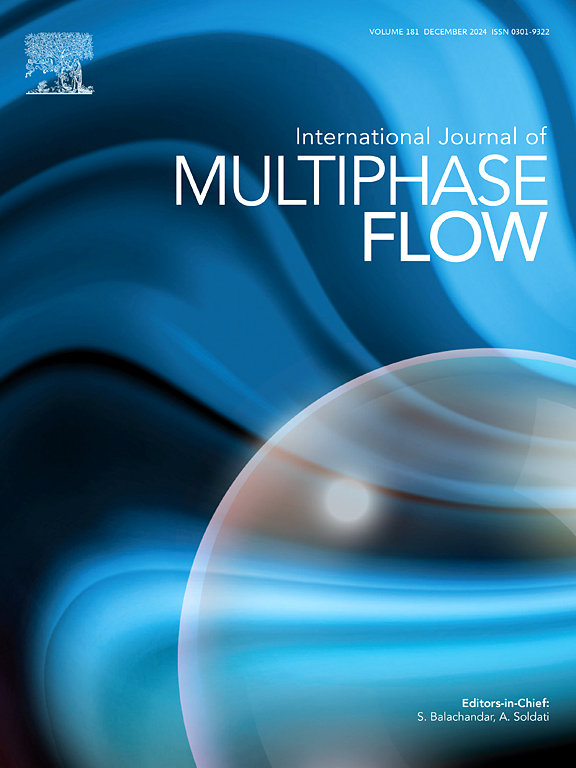二元熔融玻璃微球液滴共向碰撞行为的数值分析
IF 3.8
2区 工程技术
Q1 MECHANICS
International Journal of Multiphase Flow
Pub Date : 2025-07-12
DOI:10.1016/j.ijmultiphaseflow.2025.105366
引用次数: 0
摘要
熔融玻璃微球的共向碰撞行为对其球性和物理性质起着至关重要的作用。以前的研究主要是研究反向移动的液滴的正面碰撞。然而,控制共向碰撞的机制仍然没有得到充分的了解。为了弥补这一差距,使用开源求解器Basilisk开发了一个三维数值模型,该模型将流体体积(VOF)方法与自适应网格细化(AMR)相结合,以模拟熔融玻璃微球的碰撞。通过对液滴形貌演变、速度场和压力分布的详细分析,与实验观察结果相比较,系统地研究了速度比和半径比对共向碰撞动力学的影响。确定了五种不同的碰撞机制:(Ⅰ)弹跳,(Ⅱ)合并,(Ⅲ)无卫星液滴的反射分离,(Ⅳ)单个卫星液滴的反射分离,以及(Ⅴ)与弹射卫星液滴的反射分离。结果表明,增加速度比可以使碰撞结果从弹跳或合并转变为反射性分离。当半径比接近于1时,只有在高速比下才能观察到卫星液滴的形成,而显著的液滴尺寸差异促进了聚并。此外,还分析了碰撞前后的动能与表面能之间的转换关系。研究结果表明,KE最初在撞击时转化为SE,随后在轴向拉伸过程中部分转化回KE。构造了一个状态图来对碰撞结果进行分类,突出了速度和半径比在状态转换中的关键作用。该研究为支持熔融玻璃微球生产工艺的优化提供了理论见解。本文章由计算机程序翻译,如有差异,请以英文原文为准。

Numerical analysis of binary molten glass microspheres droplets co-directional collision behavior
The co-directional collision behavior of molten glass microspheres plays a crucial role in determining their sphericity and physical properties. Previous studies have predominantly examined head-on collisions of counter-moving droplets. However, the mechanisms governing co-directional collisions remain inadequately understood. To bridge this gap, a three-dimensional numerical model was developed using the open-source solver Basilisk, which incorporates the volume-of-fluid (VOF) method with adaptive mesh refinement (AMR), to simulate molten glass microsphere collisions. In comparison with experimental observations, the effects of velocity ratio and radius ratio on co-directional collision dynamics were systematically investigated through detailed analyses of droplet morphology evolution, velocity fields, and pressure distributions. Five distinct collision regimes are identified: (Ⅰ) bouncing, (Ⅱ) coalescence, (Ⅲ) reflexive separation without satellite droplets, (Ⅳ) reflexive separation with a single satellite droplet, and (Ⅴ) reflexive separation with an ejected satellite droplet. The results demonstrated that increasing the velocity ratio shifts collision outcomes from bouncing or coalescence to reflexive separation. Satellite droplet formation was observed only at high velocity ratios when the radius ratio approaches unity, whereas a significant droplet size disparity promoted coalescence. Additionally, the transformation between kinetic energy (KE) and surface energy (SE) before and after collision was analyzed. The findings revealed that KE was initially converted into SE upon impact and subsequently partially transformed back into KE during axial stretching. A regime map was constructed to classify collision outcomes, highlighting the pivotal role of velocity and radius ratios in regime transitions. This study provides theoretical insights to support the optimization of molten glass microsphere production processes.
求助全文
通过发布文献求助,成功后即可免费获取论文全文。
去求助
来源期刊
CiteScore
7.30
自引率
10.50%
发文量
244
审稿时长
4 months
期刊介绍:
The International Journal of Multiphase Flow publishes analytical, numerical and experimental articles of lasting interest. The scope of the journal includes all aspects of mass, momentum and energy exchange phenomena among different phases such as occur in disperse flows, gas–liquid and liquid–liquid flows, flows in porous media, boiling, granular flows and others.
The journal publishes full papers, brief communications and conference announcements.

 求助内容:
求助内容: 应助结果提醒方式:
应助结果提醒方式:


